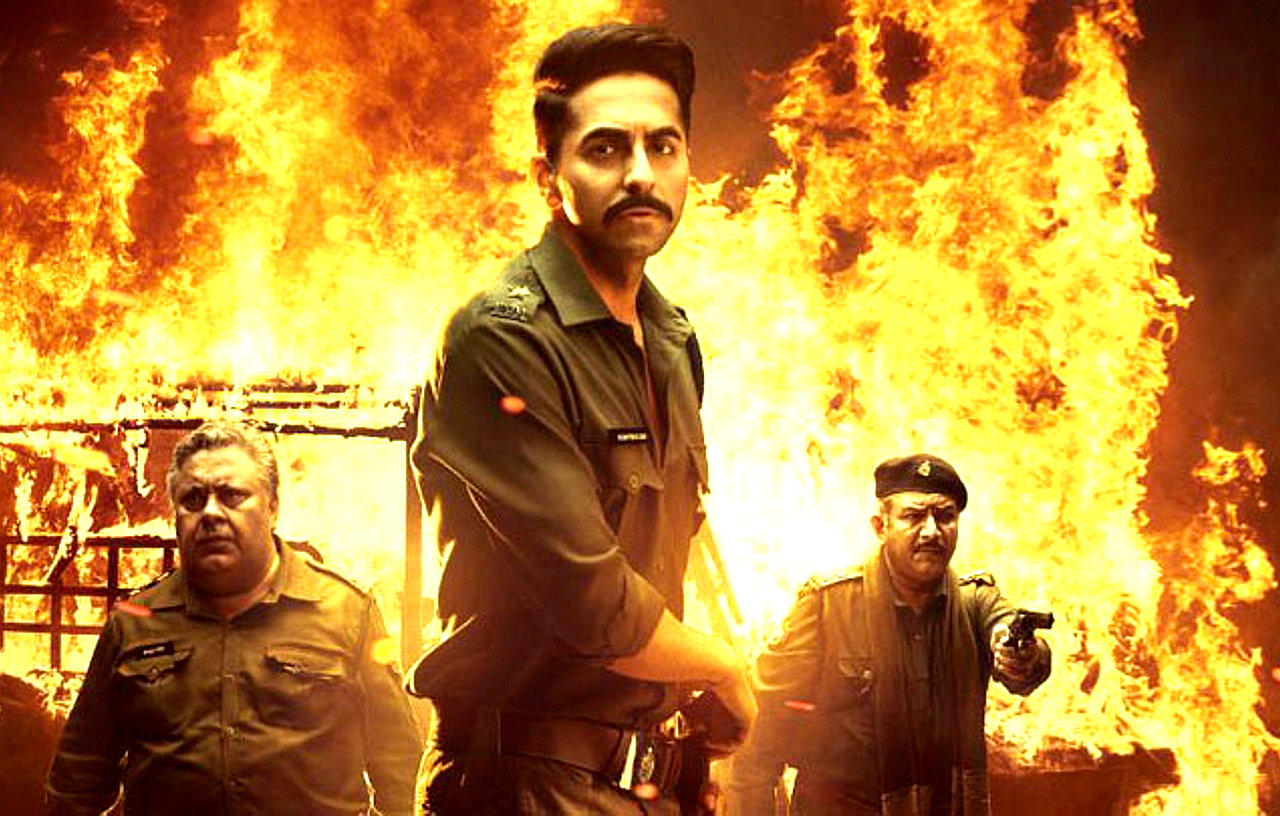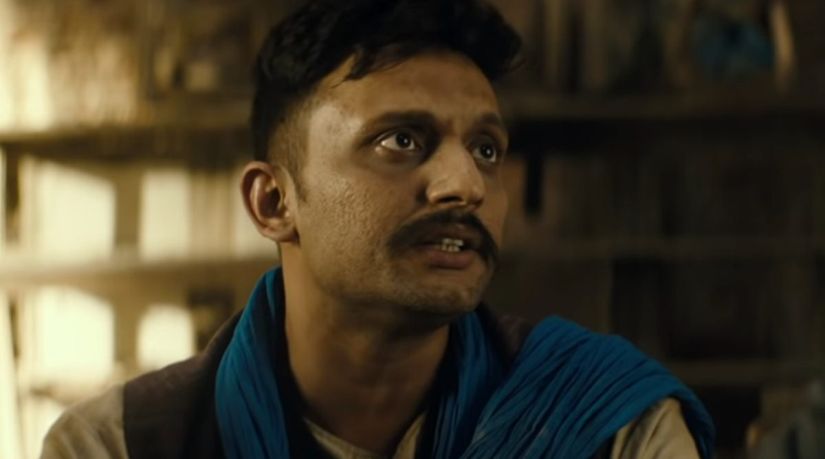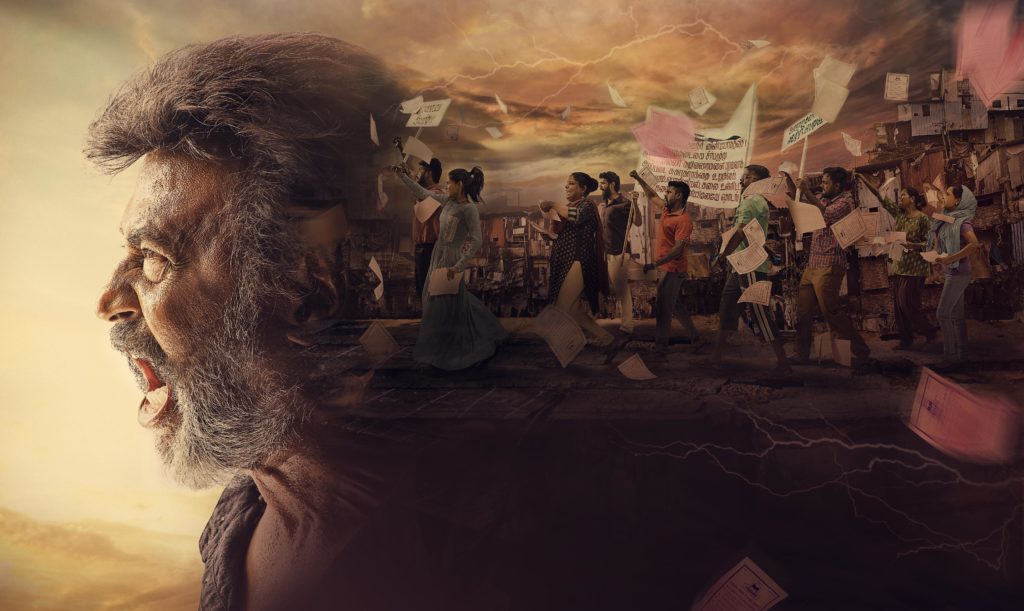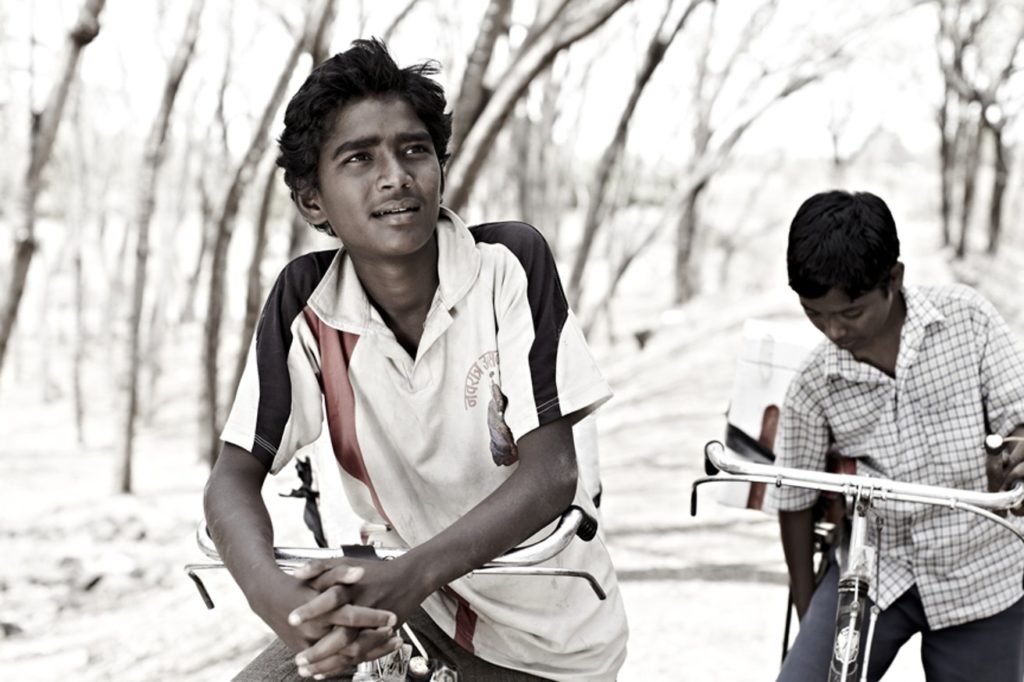“Although there is no comparison between Article 15 and Pa Ranjith’s Kaala, but still, it is tempting to look into their ways of direction because these two are the only Bollywood films in recent times, having Bahujan issues as the main theme. Unlike Article 15, in Kaala, Dalits are not always dirty and helpless, waiting for an upper caste Hero. They have their own hero from within the community who has himself faced everything being an insider, and knows the remedies, and does not feel he is doing any favour to the poor. He is independent to take stands for himself and his community.” Mayura Chaudhari writes.
As a shift from his early-career entertainment films, Anubhav Sinha has now started to make a business out of ‘serious films’, and here comes Article 15, after Mulk. Sinha seems to be keen on the Constitution of India and its relevance for Bahujan communities of this country, but sadly, he does not have enough anubhav to look at things from a Bahujan perspective. The outcome is that his film, not surprisingly, tries throughout to glorify Brahmin Heroism.
It made sense when Sinha in his interview for Scroll.in published on 1st July said, as an explanation for his signing up a Brahmin in the lead role, that “It is the privileged who should challenge privilege, because the privileged have created this system.” I do agree with the concept of the savarnas working as anti-caste activists. But their deeply inherited entitlement of dominating and becoming a ‘Raja’ everywhere is problematic. When savarnas ‘come down to the ground’ for annihilating caste-based discrimination, they forget to annihilate the caste system. This is often observed in their pseudo-activism of kicking out existing Bahujan anti-caste activists and narratives, and in the use of their privilege to assume leadership of such a struggle that is in fact directed against their own creation – caste. Finally, they end up earning the fame and satisfaction of “caring for the poor Bahujans who cannot fight for themselves.”
This is precisely what can be seen in Article 15 too: the ‘Subaltern cannot speak’ for themselves and thus needs a savior superhero from the oppressor community. The funniest part is, these people, who are less than 25 percent of the Indian population, are on all sides. They will oppress and they will save. Our Brahmin protagonist Ayan’s character in the film is also in a dilemma – whether to do or not do this ‘Hatke’ thing of doing some good to the society by ‘un-messing’ one of the most complicated social systems in human history – the Varna system.
He is a learned, foreign-returned, Brahmin, upper-rank police officer who initially finds it difficult to speak in fluent Hindi, but being a Brahmin again, he is so smart that he learns the language quickly. He proves this when he gives it back like a bash on the face of a CBI officer, by reciting completely ‘shuddh’ Sanskritized Hindi sentences with confidence and pride. At the same time, it was ‘funny’, and perhaps the only ‘fun moment’ in the film, when Kumud Mishra’s character – a constable from a Scheduled Caste – is unable to understand English. He is the only character who cannot understand English. Even the small girl Amali – sister of another constable, who works at Ayan’s place as a maid – knows English. This is nothing but the typical stereotype that Dalits cannot understand or speak good English while Brahmins are born with merit from their mother’s womb.
The plot
A Brahmin IPS officer (Ayan) comes to a village, where two dalit girls have been raped and killed by upper castes. The movie revolves around the search of a third missing girl who is the friend of the other two. During this time, the IPS officer comes across several other incidents where he gets to know about caste discrimination, and then tries to fight against it and seek justice for oppressed castes.
Justification of caste based occupation- a Gandhian perspective
There is a scene in the movie in which Dalit protesters put garbage on the road in front of the protagonist’s office, as a protest against the Una caste atrocity. The protagonist is then shown as walking through the same sewage water and garbage. The entire portrayal is in order to glorify his efforts. This again shows the supremacy of a Brahmin. Also this hero needs a Bahujan girl to work at his home – a casteist and patriarchal practice which is not questioned at all in the film.
While searching for the third missing girl in the lake named as ‘Suwar Taal’ (Pig’s Lake), instead of asking his so called upper caste colleagues to do the same, he emotionally pressurizes the Bhim Sena chief to break the hartal and send workers from the SC community to search for the girl. Because according to our greatest Indian ever — Mr. Gandhi — ‘Harijans’ do cleaning work and god becomes happy on them and thus they are indeed serving God; so it is their work and they do not have the agency to deny. This is enough to conclude that the film does not question casteism, but in fact glorifies it.
“Happy realization” dialogues
“Brahmano ko bhi toh kabhi utarna padega keechad me! [Even Brahmans will have to get into the muck at some point!]”
Of course! What else? Ye keechad failaya hi tumne hai! [It is you who have created this muck in the first place!] Sooner you understand it, the better it is for you!
And yes it is impactful that the Brahmin protagonist himself says this in the film. If it was said by Nishaad or any other character, the impact would have been lesser. Also the dialogue, “Hum kabhi Harijan ho jaate hain to kabhi Bahujan, bass ‘Jan’ nahi ban paa rahe” [“Sometimes we are Harijan, sometimes Bahujan, but we never try to become ‘jan’ i.e., people”], has a lot of weight. But the term ‘Harijan’ given by Mohandas K. Gandhi is objectionable, as Harijan is not a dignified word to be accepted. Sadly we can’t ignore the fact that this word is used by both in society – the upper castes and the uneducated SCs – while referring to their Identity.
Scenes inspired by Real Incidents
Let’s take up the issue of the Badayun case from 2014, and several such caste-based crimes happening daily in some or the other corner of our country, reports we see just for a day or two in the news and then forget. Only some groups of Dalits come on to the streets to agitate in protest against those continuous incidents, get beaten up by the police, then have cases filed against them, and spend years and years in court over those cases until the next such case happens. These issues hardly come into mainstream limelight, and we must commend director Anubhav Sinha for the decision to bring up such incidents through this film.
These realities are however shown in the film in a mild way – for example, when it comes to the beating of Dalits in Una, or manual scavengers going down into the gutters to clean. Possibly because the realities are far more pathetic than what can be shown and watched on the big screen.
The scene of SC-ST communities’ agitation not to work anymore with dirt and putting all the garbage in front of the police station, could have been shown in a better way. It could have been made clearer, that this is their form of protest against the inhuman practices, instead of showing it as something wrong. Also in reality, after the Una case, the Dalits in Gujarat did put up the same kind of protest – they threw dead cows and animals in front of municipal offices.
I appreciate the fact that at least Bollywood is recognizing that casteism does exist, even if it’s in 2019, and is the most serious issue of our country. However, if the director is really concerned about caste, he should also make movies about his own upper-caste locations, instead of merely using Bahujan lives and society as raw material for a production, where both the maker of the film, and the intended audience of the film are upper castes.
Nishaad as Chandrashekar Ravan
Heroes from the community are everywhere robbed of their importance – and the same can also be seen in the film with Nishaad’s character, whom I could clearly relate to the Bhim Army Chief Adv. Chandrashekhar Ravan. Although I like Zeeshan Ayyub as an actor who has been playing quite versatile roles in Bollywood, here I felt he couldn’t do justice to the real character of Chandrashekhar Ravan. It was expected to be a more dynamic character, but of course, the director might not have wanted that to happen, lest it overpower our lead Brahmin protagonist’s character, played by Ayushman Khurana.
But at least they should have given more space to Nishaad’s character. For example, the film could have had more scenes of him fighting for Dalit rights. It could have had a scene of him motivating his people to revolt and deny tolerance for the inhuman treatment by the so-called ‘upper castes’, instead of the scenes such as the one where he is crying in his girlfriend’s lap.
Also, I felt a strange warning being delivered by the scene where Nishaad is encountered, because Ravan is still alive; does the director want us to believe that Chandrashekhar’s end would be like this?
The Female Characters
The film starts with the murder of two minor girls who were courageous enough to raise their voices for their rights, and demand an increment in wages by just 3 rupees. But they are gang-raped and killed. The protagonist’s girlfriend, Aditi – a journalist – doesn’t seem to do much other than being one of those women used to justify the phrase, ‘Behind every successful man, there is a woman’. She wasn’t shown doing much as a journalist in her own right.
Gaura, a Dalit woman whose sister was missing, initially seems to be a strong character – someone who has her own agency. But towards the end we see that even those credits go to her boyfriend Nishaad, who ‘made her that way’ – presumably because he is educated and wanted to become a scientist or a writer, while she is uneducated and got a job to cook mid-day meals in a government school.
Another girl, Amali, who is a teen-aged girl and the sister of a constable, is not going to school/college, but is cooking in the protagonist’s kitchen; and is very happy with it as she doesn’t have bigger dreams. There is no single woman police-person shown in the film. I was glad to see at least a female doctor who is strong enough to take a stand, and to be honest to her profession. But that is certainly not enough. The film, along with the Brahmin gaze, is also made with a patriarchal gaze.
Why Mr. Gandhi and not Dr. Ambedkar?
There is a scene in which the protagonist of the film is sitting in his office, where there are photos of Gandhi on one side and Dr. Ambedkar on the other. While thinking about fighting against caste, he looks towards Gandhi. He never turns towards Dr. Ambedkar to look for answers to his questions. Even if the film talks about Article 15 of the Constitution that was written by Dr. Ambedkar, it fails to discuss his anti-caste ideology and tries to show Gandhi as an answer to the caste system.
The film ends with a scene in which the Brahmin protagonist sits on the floor and eats with his colleagues from SC and OBC communities, with the background music of “Vaishnav jan toh tene kahiye je, peed parayi jane re [One who is a Vaishnav (Devotee of Vishnu) Knows the pain of others]” – a favourite Bhajan of Gandhi. The message this sends is that caste is ‘parayi peed’ [‘others’ pain’] for the Brahmin protagonist, and not his own issue. Moreover, a human being is eating together with other fellow human beings – what is there to celebrate in this? But that is exactly what this scene does.
Social location of the Director and Changing Perspectives
We can clearly see the difference in the art of direction, based on the social locations of directors. Although there is no comparison between Article 15 and Pa Ranjith’s Kaala, but still, it is tempting to look into their ways of direction because these two are the only Bollywood films in recent times, having Bahujan issues as the main theme. Unlike Article 15, in Kaala, Dalits are not always dirty and helpless, waiting for an upper caste Hero. They have their own hero from within the community who has himself faced everything being an insider, and knows the remedies, and does not feel he is doing any favour to the poor. He is independent to take stands for himself and his community.
Also ‘Jabya’ from Nagaraj Manjule’s Fandry, even after being so oppressed, still picks up the stone and fights for himself. Fandry is different by a long way from all the typical Bollywood films made on inter-caste/inter-class/inter-religious romance, where the hero proves his love for his female lead and successfully earns her love after getting beaten up throughout the film, while suddenly attaining supernatural powers to beat up 10 people at a time. These story-tellers must open their eyes to reality, where nothing like this happens, and in fact Bahujan men get killed in public for trying to love an upper-caste woman. There are several recent cases, such as of Nitin Aage from Ahmed Nagar, Maharashtra and Pranay from Telangana. Parshya’s character from Nagraj Manjule’s superhit film Sairat also tells the story of these real characters, and not some Dilwale Dulhaniya Le Jayenge-type supernatural heroism.
This connection of the film-maker with reality and looking at the society from within – changes the perspectives and aesthetics of a film entirely. It may not entertain you or leave you with a happy ending, with everything resolved at the end, like was shown in Article 15. Because nothing has been resolved in the real world yet. Although it is not expected that a 3-hour long movie will change anything in society, but surely a movie on such a topic is expected to make people think harder about the issue.
It should be ok if at times the viewers do not walk out of the theatre with a smile, discussing samosa/popcorn, but instead with a question. A question to oneself: Are they knowingly or unknowingly practising casteism or supporting it in any way? Questions that may need time to find answers to.
The author is a freelance journalist and anchor.
Cover Image is sourced from the Internet.





